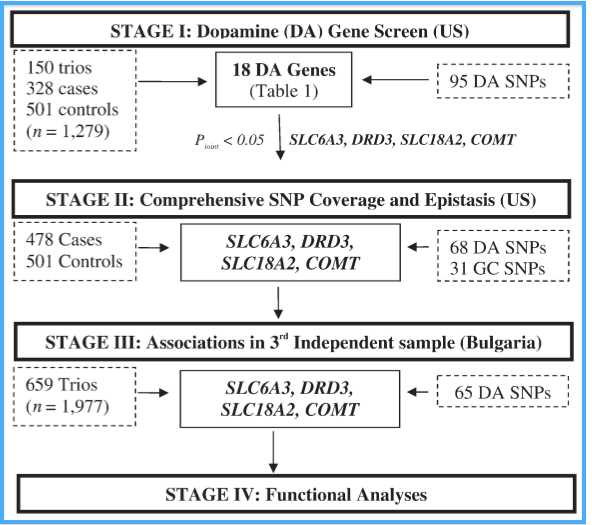

This web page was produced as an assignment for an undergraduate course at Davidson College.
Study: A network of dopaminergic gene variations implicated as risk factors for schizophrenia
Authors: Talkowski, M.E., Kirov, G.E., Bamne, M., Georgieva, L., Torres, G., Mansour, H., Chowdari, K.V., Milanova, V., Wood, J., McClain, L., Konasale, P., Shirts, B., Zhang, J., O'Donovan, M.C., Owen, M.J., Devlin, B., & Nimgaonkar, V.L.
Published in Human Molecular Genetics
Overview
In this article, Talkowski et al. (2008) performed a multi-stage genomic analysis to detect and evaluate potential associations among genes related to dopaminergic (a monoamine) functioning as well as investigate their potential connection to the psychiatric condition Schizophrenia. Their goal was to find polymorphisms (different alleles) of these genes that were associated with dysfunction of the dopaminergic (DA) system, as denoted by a diagnosis of Schizophrenia. One of their candidate genes was SLC18A2 (VMAT2), and they provide evidence that polymorphisms of this gene in tandem with other dopamine-associated genes contribute to Schizophrenic symptomology. A brief description of their methodology and findings is provided below, followed by a comparison of their report to that of the popular press (TIME article).
Methodology
Talkowski et al. (2008) broke their study into four distinct stages, which they explain was done to make the process of genomic screening faster. They began with initially screening a large network of DA-related genes and then closely analyzed those genes that stood out as potentially significant candidates for polymorphic abnormalities.
Stage one involved the screening of 18 genes associated with dopamine transmission in both patients diagnosed with Schizophrenia and control (undiagnosed) subjects. They chose to evaluate dopamine-related genes because the DA system is believed to play a large role in this psychiatric condition; Schizophrenic patients are prescribed pharmacological agents that reduce DA transmission (antagonists) and have shown increased sensitivity to drugs that enhance synaptic dopamine release. In particular, the authors confined their investigation to DA genes previously linked to Schizophrenia from prior genetic association studies.
From there, they found potentially significant associations in four genes, one of which was SLC18A2.
Stage two consisted of genotyping approximately 60 single nucleotide polymorphisms (SNPs) in each of the four genes, which led them to find significant associations between SNP and the disease phenotype. SNPs are denoted by a change in one base in a DNA sequence (or gene), like the VMAT2 C-A variation Hamer found. Furthermore, the authors performed statistical analyses to determine whether any interactions between the genes’ expression were detectable, a phenomenon known as epistasis. In specific, they found that approximately 41% of the identified interactions involved the gene SLCA3, which encodes a dopamine transporter.
Stage three involved confirming the findings from the prior stages in a different population (Bulgarian participants as opposed to American subjects). More statistical analyses confirmed that the stage one and two findings were significant, meaning these genes may play a role in influencing Schizophrenic phenotypes.
Stage four involved analyzing two of the genes (neither of which was SLC18A2) they identified as significantly associated in stage one for functional differences (using two assays that depict protein function). A signficant difference in protein function related to polymorphism was found with one of the genes.
The authors' study design is depicted visually by the below figure:

Taken together, the authors concluded that their study offered substantial evidence that polymorphisms of many DA-related genes may interact to affect Schizophrenia symptomology. How does their report compare to that of the popular press?
Popular Press
It is not hard to find marked differences in how this peer-reviewed journal article conveys its findings in comparison to the story of VMAT2 told by TIME. In particular, much more detail on the methodology is included, comprising the majority of the article rather than one or two watered-down sentences. For example, the authors discuss information such as the number of participants in the study as well as the databases and programs used to detect and analyze the SNPs. In return, very little discussion is included on the implications of these findings, sticking instead to the facts of the study. Similarly, the introduction spends little time describing the disease and rather focuses on providing background on previous scientific evaluations. In this regard, the article does tell a story, but the nature of the report is very different than TIME's sensationalistic depiction of VMAT2. As Kua et al. (2004) explain, what is said by different publications (journal articles vs. popular press) is often the most distinct difference rather than how the information is conveyed.
Additionally, Talkowski et al. (2008) walk the reader through all parts of their investigation with enough detail that their study could be replicated by someone well-versed in the field of genomics and/or molecular genetics. Such information is important for helping to ensure the reliability of the study by providing transparency, a critical component of scientific literature. While this information is not of benefit to the layman, it is crucial for this perspective on the story.
Moreover, the background their article provides helps to situate the reader in the context of recent literature related to their study by describing other genes associated with DA transmission, rather than focusing only on what they have done (the TIME article did not bother to address other genes or functions of VMAT2). Lastly, the implications of the authors' findings are not taken out of context, nor do they implicate that they will answer more questions than what they sought to address; Talkowski et al. (2008) assert that their data suggest associations in DA-related polymorphisms may contribute to Schizophrenia pathology, a cautious, but not unfounded, conclusion.
Genomics Page
Biology Home Page
Email Questions or Comments to kaswart.
© Copyright 2011 Department of Biology, Davidson College, Davidson, NC 28035